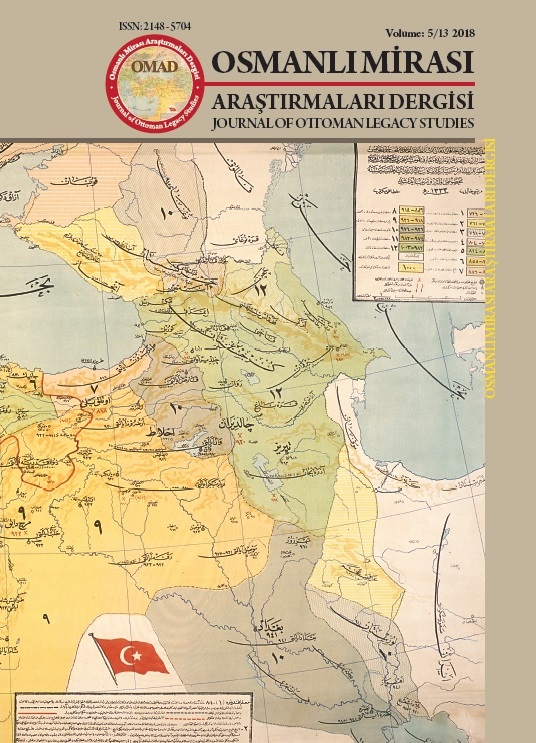TAPU TAHRİR DEFTERLERİNE GÖRE XVI. YÜZYILDA VARTO NAHİYESİ
District of Varto During The 16th Century According to Land Registry Books
DOI:
https://doi.org/10.17822/omad.2018.119Keywords:
Varto, Hınıs, Tapu Tahrir, Nahiye, NüfusAbstract
Öz: Günümüzde Muş iline bağlı bir ilçe olan Varto’nun Osmanlı hâkimiyetine geçişi I. Selim’in, Şah İsmail
ile yaptığı ve Osmanlı ordusunun başarısıyla sonuçlanan Çaldıran Savaşı sonrasına denk gelmektedir. Varto’nun
nahiye statüsünü kazanması ise 1539 yılından sonra Hınıs’ın sancak konumunda Erzurum beylerbeyliğine
bağlanmasıyla gerçekleşmiştir. Bu tarihten sonra belirli zaman aralıklarıyla Varto’nun da dâhil olduğu bölgenin
tahriri yapılarak defter hâline getirilmiştir. Anlaşıldığı kadarıyla Varto ile ilgili tutulmuş kayıtlar 1538 tarihine kadar
gitmektedir. Ancak bu kayıtları içeren defterler nahiyenin genel durumu hakkında yeterli bilgi vermemektedir. Bu
nedenle 1556 yılına kadar nahiyenin sosyal ve ekonomik yapısı hakkında detaylı verilere ulaşmak mümkün
olmamıştır. Tespitlerimize göre Varto ile ilgili kayıtlar 1556 yılından itibaren düzenli ve sistematik bilgiler
içermektedir. Söz konusu tarihten itibaren tutulan kayıtlardan 1556-1568 yılları arasında Varto’nun 93-95 köyü ve
51-54 mezrası olduğu anlaşılmıştır. Bunun yanında 1556 yılında nahiyede tahminen 3.902, 1568 yılında ise 6.394
kişinin yaşadığı tespit edilmiştir. Bu çalışmada XVI. yüzyılda yapılmış tahrir kayıtları incelenmiş ve Varto
nahiyesinin o yüzyıldaki nüfus, yerleşme ve ekonomik yapısı üzerinde bazı tespitler yapılmıştır. Yüzyılın başlarında
bölgedeki Safevî tehlikesi, Varto’nun sosyal ve ekonomik durumunu etkilemişse de bu etki yüzyılın sonuna doğru
oldukça azalmış, sağlanan huzur ve barış ortamı hem nüfusunun hem de tarımsal faaliyetlerin artışına neden
olmuştur.
Anahtar Kelimeler: Varto, Hınıs, Tapu Tahrir, Nahiye, Nüfus
Abstract: The district of Varto that is now part of the city of Muş became part of the Ottoman Empire after
the Battle of Çaldıran between I. Selim and Şah Ismail which was won by the Ottoman army. Varto became a district
after Hınıs became part of the Erzurum province after 1539. Afterwards, regional land registry records were kept at
certain time intervals for the region including Varto and registry books were prepared. As far as we can understand,
the records on Varto date back to 1538. However, the books that include these records do not give sufficient
information on the general status of the district. Hence, it has not been possible to obtain detailed information on the
social and economic structure of the district until 1556. According to our findings, records on Varto contain regular
and systematic information starting from the year 1556. It has been understood from these records that Varto has 93-
95 villages and 51-54 hamlets during the years of 1556-1568. In addition, it has also been determined that the
population of the district was 3.902 in 1556 and 6.394 in 1568. In this study, detailed registry records during the 16th
century were examined and various conclusions were drawn regarding the population, settlement and economical
structure of the Varto District. The Safevî threat at the region during the beginning of the century had an impact on
the social and economic status of Varto, however this impact declined towards the end of the century and the
resulting peaceful environment caused an increase in the population as well as in agricultural activities.
Keywords: Varto, Hınıs, Land Registry, District, Population








